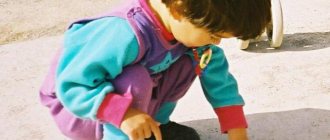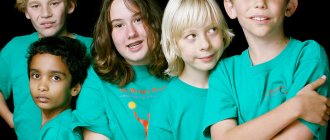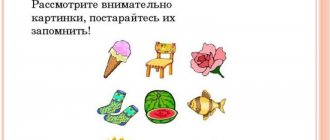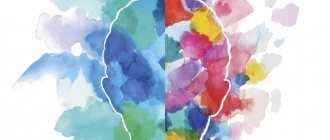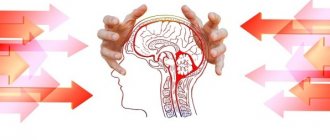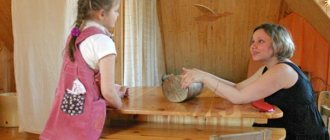Autism is a complex of disorders in behavior and reactions in which the skills of communication, adaptation to the social environment and control of one’s behavior in society are greatly affected. With such manifestations, it is difficult to exist normally in a world where dialogue and interaction are the basis for a full life.
Therefore, correctional activities and games are needed, aimed at the child’s social adaptation and improving his contact with the environment.
What is childhood autism
Childhood autism
is a disorder that occurs due to disturbances in brain development.
The disease is characterized by a pronounced comprehensive deficit of communication and social interaction, repetitive actions, and limited interests. All of these signs can be noticed before the age of three. Similar conditions, in which milder manifestations are observed, are classified as autism spectrum disorders.
Simply put, childhood autism is a neurodevelopmental disorder. It is characterized by a variety of symptoms, many of which first appear in infancy or early childhood. Example: inadequate reactions to discomfort, too strong reactions of fear or crying in response to minor changes in the environment or a weak sound stimulus. A weakened response to feeding position is also characteristic. The reactions of the “revitalization complex” are distorted - an affective readiness for contact with adults is demonstrated. The reaction of animation can manifest itself in the absence of an adult, relating to an inanimate object. In adults, symptoms persist, but in a milder form. It is impossible to determine childhood autism by one symptom.
The diagnosis is characterized by:
- violations in mutual communication;
- lack of social interactions;
- repetitive actions, limited interests.
Seminar for teachers
Contents: What is autism? Features of the behavior of an autistic child Signs of autism Stages of helping an autistic child Methods of working with autistic children Recommendations for working with autistic children What to play with a small autistic child Memo for teachers “Signs of autistic disorders in children” Methods of working with autistic children Presentation “ Portrait of an Autist"
The purpose of the seminar: to develop teachers’ psychological and pedagogical competence to work with children with autism spectrum disorder. Duration: 2.5–3 hours.
Introductory speech by a psychologist
Nowadays, the word “autism” can often be heard from parents and teachers. People first started talking about autism in Russia in the late 1980s. Then K.S. Lebedinskaya proposed creating special educational institutions to provide qualified assistance to children with autism spectrum disorders (ASD). Unfortunately, the proposals were not implemented at that time. And it still remains completely unclear where and how to educate such a child. In most cases, children study at home without the opportunity to attend age-appropriate group classes. But autism is a disorder of the ability to communicate, so it is very important that corrective assistance is provided to children and their parents in a timely manner.
Federal Law No. 273-FZ of December 29, 2012 “On Education in the Russian Federation” states that every educational institution is obliged to create conditions for the learning and development of children with special educational needs. But how to create these conditions is not stated either in the law or in any by-laws.
The only regulatory document regulating the organization of work with autistic children is a letter of instruction, which was developed by the Laboratory of Content and Methods of Teaching Children with Emotional Disorders of the Moscow Institute of Correctional Pedagogy under the leadership of O.S. Nikolskaya and E.R. Baenskoy. The letter outlines the principles of working with autistic children, analyzes the possibilities of teaching them in inclusive groups and classes, but does not describe the system for integrating such classes into a mainstream school. This process is not provided with a legislative and legal framework.
Meanwhile, according to experts, currently one child in a thousand has developmental disabilities called ASD. Despite this, many parents in Russia still do not have the opportunity to receive adequate help and support, and do not understand where and how they can educate their children. And teachers, in turn, do not have methods of working with such children and, therefore, cannot provide them with proper assistance.
At the seminar, we will try to figure out who autistic children are, what is their peculiarity, and also consider therapy methods drawn from the experience of foreign colleagues, and determine which of these methods can be applied in the Russian education system . And most importantly, we will try to understand how to interact with such children in a public school setting.
What is autism?
The presenter invites the seminar participants to give their definitions of the word “autism” and their understanding of this term. You can ask teachers to continue the sentence: “I think autism is...” The facilitator can record the participants’ thoughts on the board or whatman paper. After this, he sums up the general result, choosing the most concise interpretation of the term: “Autism is an extreme form of communication disruption, withdrawal from reality into the world of one’s own experiences” (E. Bleuler).
The presenter offers the seminar participants other definitions of the term “autism”, which allow them to more deeply understand the topic of the seminar.
“Autism is a permanent developmental disorder that occurs during the first three years of life and is the result of a neurological disorder.”
“Autism is a developmental disorder. A defect in the system responsible for the perception of external stimuli, which causes the child to react acutely to some phenomena of the external world and almost not notice others.”
In our country, autism is a disease and is included in the ICD-10 classification of diseases under the code F84.0 - “Childhood autism”. This diagnosis can be made by a child psychiatrist to a child after three years of age.
Features of the behavior of an autistic child
The psychologist invites seminar participants to imagine a child with similar characteristics. The figure of the child is schematically represented on the board; next to the board there is a box with cards on which certain features of the child’s behavior are written. Each teacher comes to the board, pulls a card out of the box, decides whether the characteristic proposed on the card corresponds to the behavior of an autistic child, and if it does, attaches the card to the board.
During the task, the psychologist does not comment on the teachers’ answers in any way. When all participants have made their choice, the psychologist analyzes the collectively compiled portrait, noting the characteristic features of an autistic child. After the comment is completed, the psychologist asks: “Perhaps after our discussion someone wants to change their mind?” If one of the teachers realized that his answer was incorrect, he can correct it and attach the card to the board (or remove it from the board). At the same time, it is important not to focus on the mistakes of teachers.
Signs of autism
| Traits of an ordinary child | Traits of an Autistic Child |
| - constantly asks questions, - climbs on a slide, on top of the sofa, - likes to play on the playground when there are a lot of children there, - actively involves children in his play, - loves cats, - takes things apart piece by piece, - talks to strangers in public transport people, - likes colorful woolen sweaters, - likes loud music, - likes to play drums or knock, - demands new toys, - constantly rearranges toys and things in the room, - drinks from different cups | – does not make eye contact, – does not play with peers, – does not experience joy, – does not need contact with others, – does not talk to others, – repeats the same words or sentences, – performs the same mechanical movements, - plays only with certain toys, - uses constant rituals, - plays with small toys, - arranges objects in a row, - communicates with only one family member, - communicates with one selected adult, - is selective in food, - prefers food of one color, – does not like physical contact, – is selective in what he wears, – often walks barefoot, – sleeps poorly, – plays alone, – fantasizes, – makes aimless movements (waving his arms, fiddling with his fingers), – constantly intentionally follows certain rules, – resists change, - performs actions in a certain order, - performs actions that are harmful to himself, - is afraid of loud sounds, covers his ears with his hands, - avoids bright light, - sniffs objects, including inedible ones, - avoids physical activity, - does not tolerate touching to himself, - is afraid of getting dirty, - gets tired quickly, - moves chaotically around the room |
At the end of the exercise, you can show or distribute the infographic “ Memo for Educators ” to the participants.
Stages of helping an autistic child
Of course, every child is individual. Especially autistic children. They can have a variety of traits and characteristics. It is important to understand that such a child needs qualified help. There are some steps to receiving this help:
- visit a neurologist (to rule out problems related to brain development);
- visit a child psychiatrist (he will make a diagnosis);
- undergo hardware examination (EEG, MRI, ultrasound of the brain);
- seek advice from a clinical psychologist or speech pathologist;
- start working with the appropriate specialist.
Why does autism develop in children?
The development of childhood autism is caused by various factors. Some ordinary people still believe in well-known myths, despite scientific refutations. In the 70s of the last century, the theory of “soulless and cold mothers”, whose restrained attitude is the cause of the development of the disease, was popular. There is only one point close to the truth in this theory: parents of children who are faced with the symptoms of childhood autism actually touch it less often, building communication according to a logical and clear pattern, without unnecessary emotions. But it is worth understanding that such behavior is dictated by the child himself: childhood autism is characterized by a hyperreaction to touch. They also cannot track the meaning of speech if it has subtext such as humor or references to other situations - parents are forced to speak clearly, concisely and to the point. Conclusion: parental behavior has no influence; developmental disorder is primary.
Another myth about the development of childhood autism: rubella vaccines. It has been repeatedly proven that there is no connection between vaccinations and childhood autism. The true causes of the development of autism spectrum disorder are unknown, although there are factors that increase the likelihood of having a child with this disorder.
Examples:
- having relatives with autism;
- late age of parents at conception (especially the father);
- birth in a large family among the last children (7-8 and beyond);
- maternal diseases during pregnancy (tuberous sclerosis, rubella, excessive body weight).
- Cerebral palsy.
Some deviations provoke the development of autistic traits. Example: with speech impairment, hearing impairment, attention deficit disorder, signs of autism are concomitant with the underlying pathology due to distortion of perception in the child.
Manifestations of autism in newborns
In infants and newborns, external signs that indicate the presence of the disease are significantly pronounced: lack of a smile, bright emotions, activity typical of other children of their age, facial expressions and many gestures. The baby's gaze is often fixed on the same point or on a specific object.
Such children practically do not ask to be held and do not copy the emotions of adults. Autistic infants have virtually no crying, it does not create problems for parents, and they are able to independently occupy themselves for hours without showing any interest in the world around them. The baby does not gurgle, does not babble, and does not respond to his own name. Such children are characterized by some delay in development: they begin to sit and walk late, and there is retardation in height and weight.
Such children often refuse breastfeeding and do not accept the touch of their father or mother.
What symptoms can help identify disorders?
There are different signs of the disease - it depends on the degree of impairment, the specifics of the disease, severity, and age period.
In general, there are four areas that characterize developmental disorders:
- poor, distorted or absent social interaction;
- stereotypies in speech, behavior;
- communication is stereotypical, gestural, often not requiring dialogue.
Signs of childhood autism from 3 months to 2 years
- lack of a “posture of readiness” for physical contact: the baby does not reach out to his parents, does not strive to be on the chest or on the knees;
- there is no attachment to the mother or a substitute adult, as well as a complex of revival in the form of walking, smiling, physical activity;
- infrequent or absent eye contact;
- lack of interest in general games with other children and adults, as well as aggression when attempting common activities. Prefers to play alone;
- high sensitivity to sound, bodily and light stimuli. Expressed in the form of hysteria, fear;
- absence of humming, delayed expressive speech, syllabic speech. At the age of 1.5-2 years, normal speech development may occur, but subsequently regression of speech skills occurs;
- echolalia – mindless repetition of phrases and words after adults, cartoon characters, and so on;
- restless sleep, poor or selective appetite;
- ignoring speech and requests addressed to him;
- underdevelopment of role-playing games;
- attachment to a certain regime, routes, routine, position of objects, and so on.
Signs of childhood autism from 2 to 11 years
- Inadequate perception of danger: the child has no fear of heights, transport, or animals. At the same time, he may react fearfully or aggressively to ordinary objects: a spoon, a chair, a cup, and so on.
- Stereotyping and pronounced rituals, obsessive gestures.
- Peculiar development of speech or pronounced disturbances. Example: lack of the pronoun “I” and its semantic load, lack of initiation of dialogue.
- Signs of fear, aggression, laughter, hysteria for no apparent reason.
- In many cases, a violation of cognitive development is obvious, often expressed chaotically: increased attention to melodies, numbers with the inability to write, read, and the like.
During adolescence, symptoms may worsen due to hormonal changes and impaired communication and social interaction.
Autism symptoms
An autistic person's fixation on his inner world is a characteristic symptom of the disease. Autistic people are withdrawn, uncommunicative, and disconnected from reality. There are different combinations of autism symptoms.
To make a diagnosis, the presence of three of the following symptoms is sufficient:
- silence, problems with speech (autistic people start speaking very late);
- speech defects, exclusion of the pronoun I;
- unhealthy isolation, love of loneliness;
- violent reaction to any changes in the usual environment, rhythm of life;
- stereotypical and obsessive actions (body swaying, head shaking);
- loss of appetite;
- inability to look directly into the eyes.
It is worth highlighting the early signs of autism:
- avoiding direct eye contact;
- lack of interest in other children;
- negative reaction to touch, affection, tenderness;
- categorical rejection of certain sounds, actions, and other external factors;
- tendency to arrange objects in one line;
- silence;
- lack of a healthy sense of danger, instinct of self-preservation;
- hyperactivity or vice versa passivity;
- frequent tantrums;
- stubbornness;
- disobedience.
The voice of autistic people is calm and quiet, their speech is monotonous. The face does not express emotions, thoughtful. Autistic people answer questions in monosyllables or are completely silent. Most special children do not respond to their names or outside stimuli. They are guided by their needs and immediate desires.
Detection of early childhood autism
Recent studies indicate that the first signs of childhood autism can be detected in children at 2-3 years of age. Infants do not have a complex of animation when their parents appear in sight. They also have a lack of eye contact, a social smile, and decreased or increased sensitivity to tactile, sound and noise stimuli. However, at this age, the diagnosis of “childhood autism” is made only when symptoms are severe. Often, parents can detect obvious symptoms of the disease if their family already has children with autism spectrum disorder.
The first children in the family to receive a diagnosis of childhood autism are the last to receive the diagnosis due to the inexperience of the parents who do not notice obvious deviations in the child’s behavior. On average, the diagnosis is made at the age of 2.5-3 years. Typically, this period is characterized by an increase in general signs of impairment, as well as by the first contacts with peers in kindergartens and general development groups - the signs of impairment stand out more noticeably against the background of other children. By the age of 3, children are expected to develop certain skills, and in autistic people these skills are delayed or not developed.
Childhood autism is a developmental disorder, and early identification of the problem will allow the child to adapt with higher efficiency. It is important not to waste the time needed to acquire different skills and abilities. Foreign experts recommend that at the age of 1-1.5 years, an independent assessment of the baby for the presence of the disease, testing the most likely deviations in autism.
To do this, answer the following questions:
- Does the child have an interest in other children?
- Does he like to be held by his parents, does he seek tactile contact while crying, before going to bed?
- Is there a role-playing game (toy cars, feeding a doll, putting a toy to sleep)?
- Is there eye contact and pointing?
- Does he like to play with his parents or other relatives?
- Does the child try to find a cat or some thing with his eyes if he points at it with his finger and names it?
Many questions are aimed at finding out the presence of contacts between the child and the outside world. If the majority of answers at 1.5 years are negative, you should consult a specialist.
Prices for a psychologist for autism
| Types of activities | Cost of one lesson/session | Duration of one lesson/session | Recommended number of classes/sessions |
| Bioacoustic correction session | 1500 rub. | 20 minutes. | 5 courses of 10-15 sessions |
| Logomassage touch | 800/1,000 rub. | 15 minutes. | from 2 times a week |
| Logomassage classic | 800/1000 rub. | 45 min. | individually |
| Individual neuropsychological session | 1,000 rub. | 45 min. | from 2 times a week |
| Individual speech therapy session | 800/1000 rub. | 45 min. | 10-15 sessions |
| Individual sensory integration session | 1,000 rub. | 45 min. | from 2 times a week |
| Individual session of sensorimotor correction | 1000/1500 rub. | 45 min. | from 2 times a week |
| Individual adaptive physical education lesson | 800 rub. | 45 min. | from 2 times a week |
| Individual lesson with an ABA therapist | 800/1000/2000 rub. | 45/60 min. | from 3 times a week |
| Diagnostic consultation with a speech therapist | 1,000 rub. | 30 min. | 1 lesson |
| Group session on productivity and communication | 800 rub. | 45 minutes | from 2 times a week |
| On-site intensive hippotherapy classes | 100,000 rub. | 100 lessons | 10 days |
| On-site intensive dolphin therapy sessions | 100,000 rub. | 100 lessons | 10 days |
offers the services of experienced specialists. Our employees are presented on this page of the site. Here you can make an appointment with them. Every psychologist working with us knows well what early childhood autism is. He masters both traditional techniques and modern correction techniques.
Working with a child diagnosed with early-onset autistic disorder always begins with diagnosis and a detailed study of the symptoms. Children behave differently, so psychological correction must take into account their individual characteristics. The information obtained is used to draw up a development program, which other specialists rely on. This allows you to solve the problem comprehensively and achieve the best result.
Help from a psychologist for children with autism involves establishing contact with the child and creating a trusting relationship. Our employees are excellent at this task.
Treatment methods for childhood autism
Unfortunately, doctors and parents today do not have methods that can completely cure childhood autism. There is no need to despair: according to modern statistics, with timely psychological and pedagogical intervention, a child will be able to realize his or her potential. There are many correctional centers that provide assistance to such children. Study information about such institutions in your city, consult with other parents of autistic people (there are many specialized forums).
Let's consider popular types of correction, rehabilitation and therapy for childhood autism.
First, let's define the categories into which treatment methods are divided:
- Biomedical correction method.
- Treatment with medications.
- Therapies that correct behavior and communication.
- Alternative and complementary medicine.
Well-known therapies that focus on communication and behavior correction.
Applied Behavior Analysis (ABA)
ABA is one of the most used types of behavioral therapy. It is based on scientific principles that allow us to formulate a child’s basic social set of knowledge and skills. The main role in the methodology is played by the motivation of children and the reward system for achievements. The child's “correct” behavior is marked with a reward - this will encourage him to demonstrate the desired behavior. Today, behavioral methods for correcting childhood autism are scientifically proven. They apply to autistic children and adults.
Early intervention for childhood autism based on behavioral therapy is the most effective method of correcting the disorder. It is very important to carefully consider the issue so as not to miss important time. Parents who pay attention to ABA are able to teach their child important skills, language use, and social interaction. In particularly successful cases, the child can learn how to ride a bicycle, how to hold a hand correctly, and so on. Behavioral therapy-based teaching methods are very useful and should be at the core of care for all patients suffering from childhood autism.
TEACCH
TEACCH is also effective in treating childhood autism. We are talking about a method called “Structured Learning”. It is based on an understanding of the details of the learning process that are characteristic of autism. Visual aids are used to successfully treat childhood autism and understand information. A large body of empirical research examining the processing patterns of autistic people has supported the TEACCH approach.
The mentioned technique is based on visual cues. They can show the child how to behave in different everyday situations - getting dressed, washing hands, brushing teeth, going for a walk, buying bread, and the like. Information is presented in an accessible form, broken down into small steps.
Speech and speech therapy
Almost all people with autism have language difficulties. Sometimes these problems are obvious. Childhood autism is characterized by almost no use of speech, no initiation of dialogue. Often the roots of the problem are not in grammar or articulation, but have to do with the “pragmatics of speech” (the use of speech to establish social contacts). Speech therapy can help many children with autism.
Ergotherapy, occupational therapy, occupational therapy
Occupational therapy or occupational therapy focuses on developing skills used in everyday life. Many autistic people have limited fine motor skills and benefit from this type of therapy. Experienced occupational therapists often have expertise in sensory integration. We are talking about an effective technology that helps autistic children overcome high sensitivity to light, sound or tactile contact.
Social Skills Therapy
Lack of communication and social skills is a serious problem in childhood autism. Many children need help developing basic skills. Example: communicating with a new acquaintance, conducting a conversation, appropriate behavior in a children's park, and so on. Therapists who teach social skills can facilitate an autistic child's social interactions with peers.
Play therapy
This may seem strange to many, but little autistic children need help not only in building social connections, but also in ordinary games. The mentioned therapy will be an excellent tool for developing communication skills and building speech. Play therapists with experience in well-known methods such as Play Project and Floortime will be especially helpful. For a positive result, it is sometimes sufficient to connect play therapy to physical, speech or occupational therapy.
Visual therapy
Many autistic people are visual thinkers. Some of them manage to interact well with communication systems that use illustrations (for example, PECS). Video games and simulations, as well as electronic communication systems, also aim to take advantage of the significant visual abilities of autistic people. You can find information about PESS and other alternative and assistive communication systems on the Internet.
Pet therapy
This type of therapy is called animal-assisted therapy. Of course, it is very effective. The main focus of pet therapy is the development of the baby’s communication skills. With close contact with animals, there is a clear improvement in the condition. Sleep improves, headaches completely disappear. Most often, horses and dogs are involved in therapy, but in some cases experts recommend communication with cats or dolphins. In general, hypotherapy, canistherapy, and dolphin therapy are treatment methods involving animals. Many parents note the effectiveness of this method itself.
Autism in adults
Adult men and women with autism are most likely to be able to live and work independently. This directly depends on their intellectual abilities and social activity. About thirty-three percent of these people achieve partial independence.
Those adults whose intelligence is reduced or communication is reduced to a minimum require a lot of attention. They cannot be without any kind of guardianship, which significantly complicates their lives and the lives of their relatives.
People with an average level of intelligence or those with an IQ above average often achieve significant success in the professional sphere and are quite able to live a full life: get married, start a family. However, not many people succeed in this, as they have significant difficulties in relationships with the opposite sex.
